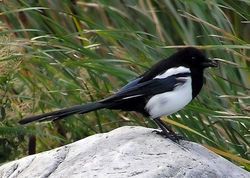Magpie
2007 Schools Wikipedia Selection. Related subjects: Birds
| iMagpie | ||||||||||
|---|---|---|---|---|---|---|---|---|---|---|
 European Magpie
|
||||||||||
| Scientific classification | ||||||||||
|
||||||||||
|
|
||||||||||
|
The magpies are medium to large, often colorful and noisy passerine birds of the crow family, Corvidae. The names ' jay' and 'magpie' are to a certain extent interchangeable, and do not accurately reflect the evolutionary relationship between these birds. For example, the Eurasian Magpie seems more closely related to the Eurasian Jay than to the Oriental Blue and Green Magpies, whereas the Blue Jay is not closely related to either.
In Europe, "Magpie" is often used as a synonym for the European Magpie, as there are no other magpies in Europe outside Iberia.
Name
The prefix "mag-" is short for "Margaret." Known for its noisy chattering, the European Magpie may have acquired its name as an allusion to nagging. It could have also been named after "Maggot" because it stole eggs and nestlings from other birds. "Pie" is the original name of the bird, from the Latin pica.
Systematics and species
According to Ericson et al. (2005), magpies do not form the monophyletic group they are traditionally believed to be; a long tail has certainly evolved (or shortened) independently in multiple lineages of corvid birds. Among the traditional magpies, there appear to be 2 evolutionary lineages: One consists of Holarctic species with black/white coloration and is probably closely related to crows and Eurasian jays. The other contains several species from South to East Asia with vivid coloration which is predominantly green or blue. The Azure-winged Magpie is a species with a most peculiar distribution and unclear relationships. It may be the single survivor of a long extinct group of corvid genera.
Other recent research (Lee et al., 2003) has cast doubt on the taxonomy of the Pica magpies, since it appears that P. hudsonia and P. nuttalli may not be different species, whereas the Korean race of P. pica is genetically very distinct from the other Eurasian (and even the North American) forms. Either the North American, Korean, and remaining Eurasian forms are accepted as 3 or 4 separate species, or there exists only a single species, Pica pica.
Holarctic (black-and-white) magpies
- Genus Pica
- European Magpie, Pica pica
- American Black-billed Magpie, Pica hudsonia (may be conspecific with P. pica)
- Yellow-billed Magpie, Pica nuttalli (may be conspecific with P. pica/P. hudsonica)
- Korean Magpie, Pica sericea (may be conspecific with P. pica)
Oriental (blue/green) magpies
- Genus Urocissa
- Formosan Blue Magpie Urocissa caerulea
- Red-billed Blue Magpie, Urocissa erythrorhyncha
- Gold-billed Magpie, Urocissa flavirostris
- White-winged Magpie, Urocissa whiteheadi
- Sri Lanka Blue Magpie, Urocissa ornata
- Genus Cissa
- Green Magpie, Cissa chinensis
- Yellow-breasted Magpie, Cissa hypoleuca
- Short-tailed Magpie, Cissa thalassina
Azure-winged Magpie
- Genus Cyanopica
- Azure-winged Magpie, Cyanopica cyana
The Black Magpie, Platysmurus leucopterus, despite its name, is neither a magpie nor, as was long believed, a jay, but a treepie. Treepies are a distinct group of corvids externally similar to magpies.
The Australian Magpie Gymnorhina tibicen is conspicuously piebald black and white feathers reminding of an European Magpie, but it is not corvid at all. The black and white Magpie moth is also named for its appearance.
Other
In Old English, the European Magpie is sometimes known as a "Chatterpie".
In general, the magpie is a symbol of happiness in Chinese culture.
Sporting teams based on the Magpie
- Western Suburbs Magpies an Australian Rugby League club
- Souths-Logan Magpies an Australian Rugby League club
- Collingwood Magpies an Australian Rules Football club
- Newcastle United FC an English Football club